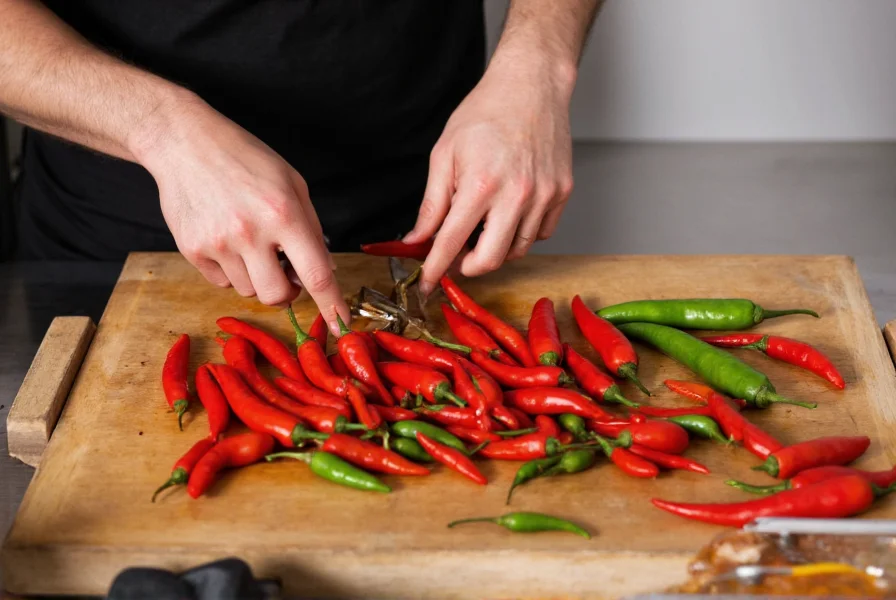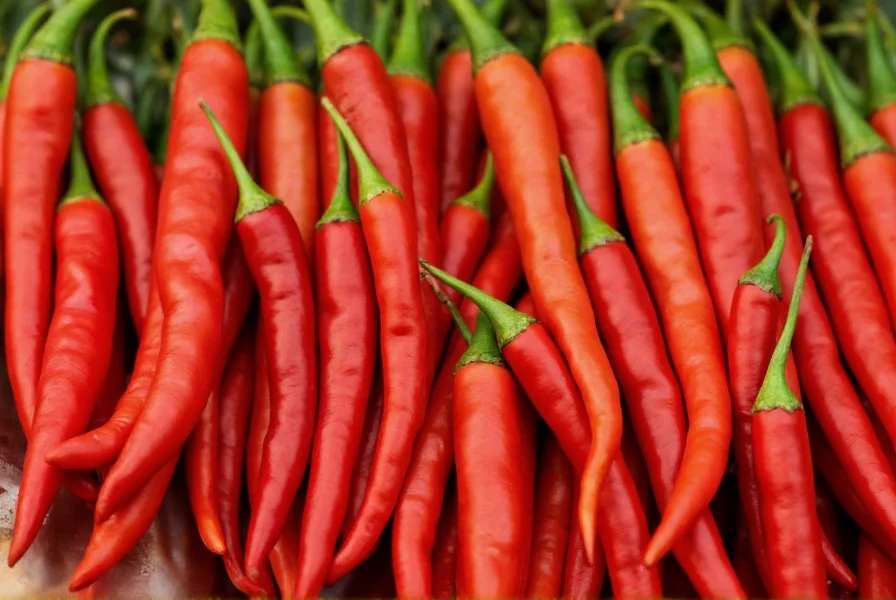Chili peppers have been cultivated for thousands of years across the globe, evolving into hundreds of varieties with distinct characteristics. Whether you're a home cook experimenting with new flavors or a culinary professional seeking precise heat control, understanding the differences between chili pepper varieties is essential knowledge. This guide explores the most common chili peppers you'll encounter, their heat levels measured on the Scoville scale, flavor profiles, and ideal culinary applications.
Understanding Chili Pepper Heat: The Scoville Scale
The Scoville scale, developed by pharmacist Wilbur Scoville in 1912, measures the pungency or "heat" of chili peppers. Originally determined through human taste testing, modern measurements use high-performance liquid chromatography for accuracy. The scale ranges from zero (no heat) to over 2 million Scoville Heat Units (SHU) for the hottest varieties. Understanding where different chili peppers fall on this scale helps prevent culinary disasters and ensures you achieve the desired flavor profile in your dishes.
Common Chili Pepper Varieties and Their Characteristics
Chili peppers vary dramatically in appearance, heat level, and flavor. Here's a detailed look at the most widely available varieties:
| Pepper Name | Scoville Heat Units | Flavor Profile | Common Uses |
|---|---|---|---|
| Bell Pepper | 0 SHU | Sweet, vegetal, crisp | Salads, stuffed peppers, stir-fries |
| Poblano | 1,000-2,000 SHU | Earthy, mild heat, slightly sweet | Chiles Rellenos, mole sauce, roasted dishes |
| Jalapeño | 2,500-8,000 SHU | Grassy, bright, moderate heat | Salsas, guacamole, pickled peppers, nachos |
| Serrano | 10,000-23,000 SHU | Sharp, bright, clean heat | Pico de gallo, hot sauces, garnishes |
| Habanero | 100,000-350,000 SHU | Fruity, floral, intense heat | Caribbean sauces, hot sauces, marinades |
| Ghost Pepper (Bhut Jolokia) | 800,000-1,041,427 SHU | Smoky, sweet, then extremely hot | Extreme hot sauces, competitive eating |
| Carolina Reaper | 1,400,000-2,200,000 SHU | Fruity, sweet, then overwhelming heat | Specialty hot sauces, novelty foods |
Regional Chili Peppers Worth Knowing
Beyond the commonly available supermarket varieties, regional peppers offer unique culinary experiences:
- Thai Bird's Eye Chili (50,000-100,000 SHU): Small but mighty, these peppers are essential in Southeast Asian cuisine, providing clean, intense heat to curries and stir-fries.
- Guajillo (2,500-5,000 SHU): Dried Mexican pepper with berry-like flavor and mild heat, perfect for mole sauces and marinades.
- Chipotle (2,500-8,000 SHU): Smoked and dried jalapeño with distinctive smoky flavor, commonly used in adobo sauce and barbecue rubs.
- Scotch Bonnet (100,000-350,000 SHU): Similar heat to habanero but with more complex tropical fruit notes, essential in Caribbean cooking.
- Shishito (50-200 SHU): Japanese pepper typically mild with occasional hot surprises, often blistered and served as a tapa.

How to Select the Right Chili Pepper for Your Recipe
Choosing between different chili peppers requires understanding both heat level and flavor profile. Consider these factors when selecting peppers:
- Heat tolerance: Be honest about your heat tolerance and that of your diners. Remember that cooking can sometimes intensify heat.
- Flavor compatibility: Smoky chipotles work well with barbecue, while fruity habaneros complement tropical salsas.
- Preparation method: Some peppers are best used fresh (like jalapeños in salsa), while others shine when dried (like guajillos in mole).
- Seeds and membranes: Most heat resides in the seeds and white membranes. Remove these for milder flavor.
Safe Handling Practices for Hot Chili Peppers
Working with extremely hot chili peppers requires precautions to avoid skin and eye irritation:
- Always wear gloves when handling very hot peppers like ghost peppers or Carolina Reapers
- Avoid touching your face, especially eyes, while working with peppers
- Wash hands thoroughly with soap after handling, even when wearing gloves
- Use separate cutting boards for hot peppers to prevent cross-contamination
- If you experience burning, use dairy products (milk, yogurt) rather than water to neutralize capsaicin
Substituting Different Chili Peppers
When your recipe calls for a specific pepper that's unavailable, these substitutions maintain similar heat and flavor profiles:
- Replace poblano with Anaheim peppers (similar mild heat)
- Use serrano instead of jalapeño for extra heat (use half the amount)
- Substitute Scotch bonnet for habanero in Caribbean recipes
- Try guajillo peppers instead of ancho for Mexican dishes
- For extremely hot peppers, use a smaller amount of a milder variety with a few drops of hot sauce

Growing Different Chili Peppers at Home
Home gardening allows access to fresh, unique chili pepper varieties. Consider these tips:
- Start seeds indoors 8-10 weeks before last frost date
- Peppers prefer warm temperatures (70-85°F) and full sun
- Provide consistent moisture but avoid waterlogged soil
- Harvest peppers at different stages for varying flavors (green vs. ripe)
- Wear gloves when harvesting extremely hot varieties
Preserving Your Chili Pepper Harvest
Extend the life of your chili peppers with these preservation methods:
- Drying: String peppers or use a dehydrator for long-term storage; reconstitute in hot water when needed
- Freezing: Freeze whole peppers in airtight containers; they'll be softer when thawed but retain flavor
- Pickling: Preserve jalapeños, serranos, and other medium-heat peppers in vinegar brine
- Oil infusions: Create chili oil with milder peppers (never use extremely hot peppers due to botulism risk)
- Sauces and pastes: Blend peppers with vinegar and salt for versatile condiments
Conclusion: Embracing the Diversity of Chili Peppers
Exploring different chili peppers opens up a world of flavor possibilities beyond simple heat. Each variety brings its own unique combination of pungency, sweetness, smokiness, and fruitiness to dishes. By understanding the characteristics of various chili peppers, you can make informed choices that enhance your cooking rather than overwhelm it. Start with milder varieties to develop your palate, then gradually explore hotter options as your tolerance and appreciation grow. Remember that the best chili pepper for any dish is the one that complements the other ingredients while delivering the desired heat level.
Frequently Asked Questions
What's the difference between a jalapeño and a serrano pepper?
Jalapeños (2,500-8,000 SHU) are larger, milder, and have a grassier flavor compared to serranos (10,000-23,000 SHU), which are smaller, hotter, and offer a cleaner, brighter heat. Serranos typically contain about three times more capsaicin than jalapeños. While jalapeños work well for stuffing and pickling, serranos are better suited for fresh salsas where their intense heat can shine.
Which chili pepper is hottest: habanero or ghost pepper?
Ghost peppers (Bhut Jolokia) are significantly hotter than habaneros. Habaneros range from 100,000-350,000 Scoville Heat Units (SHU), while ghost peppers measure 800,000-1,041,427 SHU—making them approximately 3-8 times hotter. The ghost pepper delivers an intense heat that builds gradually, whereas habaneros provide an immediate, fruity heat that dissipates more quickly.
Can I substitute bell peppers for chili peppers in recipes?
You can substitute bell peppers for mild chili peppers like poblanos in recipes where heat isn't essential, but you'll lose the characteristic pepper flavor. Bell peppers lack capsaicin (the compound that creates heat), so they won't provide any spiciness. For recipes requiring heat, consider adding a small amount of cayenne pepper or hot sauce to bell peppers to approximate the flavor profile of mild chili peppers.
Why do some chili peppers taste fruity?
Many hot chili peppers, particularly habaneros and Scotch bonnets, contain volatile compounds that create fruity flavor notes. These compounds develop as the peppers ripen and change color from green to orange or red. The fruitiness comes from esters and other aromatic compounds that balance the heat of capsaicin. Riper peppers generally have more complex flavor profiles with increased sweetness and fruit notes compared to their unripe green counterparts.
How can I reduce the heat of a dish that's too spicy?
To reduce excessive heat in a dish, add dairy products like yogurt, sour cream, or milk, which contain casein that binds to capsaicin. Acidic ingredients like lime juice or vinegar can also help balance heat. Adding sweetness through sugar, honey, or fruit can counteract spiciness. For soups or sauces, diluting with more non-spicy liquid or adding starchy ingredients like rice or potatoes can absorb some of the capsaicin. Remember that cooling methods work best when applied immediately after realizing a dish is too spicy.











 浙公网安备
33010002000092号
浙公网安备
33010002000092号 浙B2-20120091-4
浙B2-20120091-4